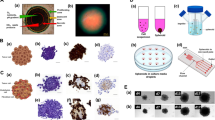Abstract
Polystyrene Petri dishes are in use in hundreds of thousands of laboratories world wide. Cell culture experiments performed in them provide fundamental information in a wide range of applications, including but not limited to testing novel biomaterials and pharmaceuticals, and stem cell research. These experiments cost billions of dollars per year. In this study we report on a potential deficiency of polystyrene Petri dishes, possibly caused by an increase in interfacial pH under relevant culture conditions and affecting cell performance. We conclude that cell performance on Petri dishes could be improved by improving the Petri dishes. As a spin-off of our study we postulate the concept that cancer cells and stem cells are social. It is impossible to validate this concept on the basis of the model established in this paper. However, the coherence of our insights may encourage further study and lead to the development of a qualitative improvement of cell culture devices, including Petri dishes and culture flasks, to the identification of potential strategies for chemotherapy and chemoprevention that could suppress progression of metastasis, and to the establishment of improved settings for tissue engineering and stem cell research. An immediate recommendation of our study is to use chemically and biologically inert substrates for important cell culture experiments, for example, nanocrystalline diamond.
Similar content being viewed by others
References
Sommer A P, Zhu D, Wiora M, Fecht H J. The top of the biomimetic triangle. Journal of Bionic Engineering, 2008, 5, 91–94.
Lo C M, Wang H B, Dembo M, Wang Y L. Cell movement is guided by the rigidity of the substrate. Biophysical Journal, 2000, 79, 144–152.
O’Brien L E, Zegers M M, Mostov K E. Opinion: Building epithelial architecture: Insights from three-dimensional culture models. Nature Reviews Molecular Cell Biology, 2002, 3, 531–537.
Comoglio P M, Trusolino L. Cancer: The matrix is now in control. Nature Medicine, 2005, 11, 1156–1159.
Cross S E, Jin Y S, Rao J, Gimzewski J K. Nanomechanical analysis of cells from cancer patients. Nature Nanotechnology, 2007, 2, 780–783.
Engler A J, Sen S, Sweeney H L, Discher D E. Matrix elasticity directs stem cell lineage specification. Cell, 2006, 126, 677–689.
Discher D E, Mooney D J, Zandstra P W. Growth factors, matrices, and forces combine and control stem cells. Science, 2009, 324, 1673–1677.
Schneierson S S, Shore B. Adaptation of the cooper recessed-top polystyrene tissue culture dish to identification and investigation of Candida and other Yeastlike Fungi. Applied Microbiology, 1965, 13, 286–287.
Wagner W, Saffrich R, Wirkner U, Eckstein V, Blake J, Ansorge A, Schwager C, Wein F, Miesala K, Ansorge W, Ho A D. Hematopoietic progenitor cells and cellular microenvironment: behavioral and molecular changes upon interaction. Stem Cells, 2005, 23, 1180–1191.
Hurst R E, Kyker K D, Bonner R B, Bowditch R D, Hemstreet G P III. Matrix-dependent plasticity of the malignant phenotype of bladder cancer cells. Anticancer Research, 2003, 23, 3119–3128.
Chen Q Z, Harding S E, Ali N N, Lyon A R, Boccaccini A R. Biomaterials in cardiac tissue engineering: Ten years of research survey. Materials Science and Engineering R, 2008, 59, 1–37.
Passier R, Oostwaard D W, Snapper J, Kloots J, Hassink R J, Kuijk E, Roelen B, de la Riviere A B, Mummery C. Increased cardiomyocyte differentiation from human embryonic stem cells in serum-free cultures. Stem Cells, 2005, 23, 772–780.
Hanjaya-Putra D, Sharon Gerecht S. Vascular engineering using human embryonic stem cells. Biotechnology Progress, 2009, 25, 2–9.
Sommer A P, Zhu D, Scharnweber T, Fecht H J. Body building on diamonds. Journal of Bionic Engineering, 2009, 6, 14–17.
Ben-Jacob E. Learning from bacteria about natural information processing. Annals of the New York Academy of Sciences, 2009, 1178, 78–90.
Wiora M, Brühne K, Flöter A, Gluche P, Willey T M, Kucheyev S O, Van Buuren A W, Hamza A V, Biener J, Fecht H J. Grain size dependent mechanical properties of nanocrystalline diamond films grown by hot-filament CVD. Diamond and Related Materials, 2009, 18, 927–930.
Pennisi E. Origins. On the origin of cooperation. Science, 2009, 325, 1196–1199.
Sandoz K M, Mitzimberg S M, Schuster M. Social cheating in Pseudomonas aeruginosa quorum sensing. Proceeding of the National Academy of Sciences USA, 2007, 104, 15876–15881.
Iuchi S, Chen H, Paesani F, Voth G A. Hydrated excess proton at water-hydrophobic interfaces. Journal of Physical Chemistry B, 2009, 113, 4017–4030.
Zhao Q, Ovchinnikova K, Chai B, Yoo H, Magula J, Pollack G H. Role of proton gradients in the mechanism of osmosis. Journal of Physical Chemistry B, 2009, 113, 10708–10714.
Szent-Györgyi A. Biology and pathology of water. Perspectives in Biology and Medicine, 1971, 14, 239–249.
Author information
Authors and Affiliations
Corresponding author
Rights and permissions
About this article
Cite this article
Sommer, A.P., Zhu, D., Scharnweber, T. et al. On the social behaviour of cells. J Bionic Eng 7, 1–5 (2010). https://doi.org/10.1016/S1672-6529(09)60186-4
Published:
Issue Date:
DOI: https://doi.org/10.1016/S1672-6529(09)60186-4




